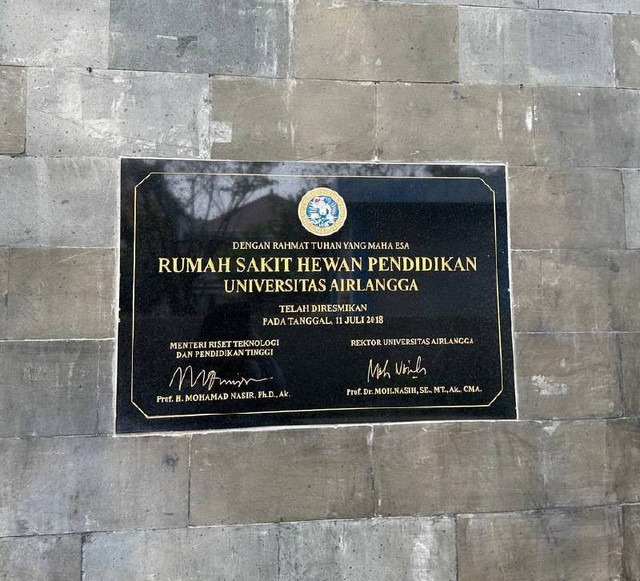Tentang KamiPedoman Media SiberKetentuan & Kebijakan PrivasiPanduan KomunitasPeringkat PenulisCara Menulis di kumparanInformasi Kerja SamaBantuanIklanKarir
2025 © PT Dynamo Media Network
Version 1.103.0
Konten dari Pengguna
Field Trip : Observation of Communication and therapeutic in a Veterinary Clinic
8 Desember 2024 13:58 WIB
·
waktu baca 4 menitTulisan dari ENG YU YING tidak mewakili pandangan dari redaksi kumparan
ADVERTISEMENT
During my visit to a UNAIR (Universitas Airlangga) Veterinary Clinic,

I observed the communication methods used by health professionals, both verbal and non-verbal, with patients (animals), pet owners, and among the veterinary team. Effective communication in health services plays a crucial role in establishing trust, ensuring proper treatment, and enhancing the quality of care. This essay will analyze my observations and reflect on how these communication strategies align with the principles of therapeutic health services.
ADVERTISEMENT
In the veterinary clinic, verbal communication was the primary mode of interaction. The veterinarians and veterinary nurses clearly articulated their thoughts, offering explanations of diagnoses and treatment plans. When speaking with pet owners, they used simple, empathetic language, ensuring that the pet owners understood the information being shared. For example, when explaining the need for vaccinations or treatments, the veterinary professionals would pause to allow questions and offer reassurance, making sure to address any concerns. Their tone was calm, compassionate, and professional, helping reduce any anxiety pet owners might have felt about their pet's health.
Effective communication was also evident when the veterinary team interacted with each other. They used precise, field-specific terminology when discussing cases but made sure to clarify terms for clients, bridging the gap between medical jargon and layperson understanding.
ADVERTISEMENT
Non-verbal communication in the clinic was equally important. Veterinary professionals used body language, eye contact, and gestures to create a supportive and comfortable atmosphere for both the animals and their owners. When talking to a nervous pet owner, for instance, a veterinarian might gently place a hand on their shoulder or use a calm and steady tone to reassure them. They also used facial expressions to convey understanding, such as nodding when a pet owner expressed concern, showing empathy without words.
Additionally, when handling animals, the veterinary staff demonstrated calm, confident body language to keep the pets at ease. Their gestures were slow and deliberate, ensuring that the animals did not feel threatened or anxious.
ADVERTISEMENT
The clinic staff, including veterinarians, nurses, and receptionists, communicated effectively with each other. During busy moments, I observed them using clear, concise instructions while handling patients, ensuring that each team member knew their role and what was required next. For example, when preparing for a surgery, the veterinary nurse would update the veterinarian on the pet’s medical history, while the receptionist ensured the necessary paperwork and client consent forms were completed. This collaborative approach ensured efficiency and the smooth running of the clinic.
When interacting with pet owners who were not familiar with medical terminology, the veterinary team adapted their communication style. They used everyday language and often provided analogies to explain medical conditions. This helped the owners feel more comfortable and empowered in making decisions about their pets’ care. For instance, when explaining a vaccination schedule, a veterinarian compared it to human vaccinations, something most pet owners could relate to.
ADVERTISEMENT
Effective communication in the veterinary clinic was essential for providing high-quality care. It helped in building trust, managing client anxiety, and ensuring proper treatment. The way information was delivered verbally and non-verbally, combined with the compassion shown by the staff, played a significant role in patient care and overall satisfaction.
In health services, especially in the field of veterinary care, understanding the importance of communication is essential. While technical expertise is necessary, the ability to communicate effectively with patients, pet owners, and colleagues can enhance outcomes. Clear communication not only improves the quality of care but also fosters a positive experience for all involved.
In conclusion, my observation at the UNAIR (Univesitas Airlangga) veterinary clinic highlighted the vital role of both verbal and non-verbal communication in ensuring effective healthcare delivery. By using clear and empathetic communication, the veterinary staff helped build trust with pet owners, reassured anxious clients, and facilitated the smooth operation of the clinic. These communication practices are essential for improving patient outcomes and creating a positive environment for both humans and animals.
ADVERTISEMENT

